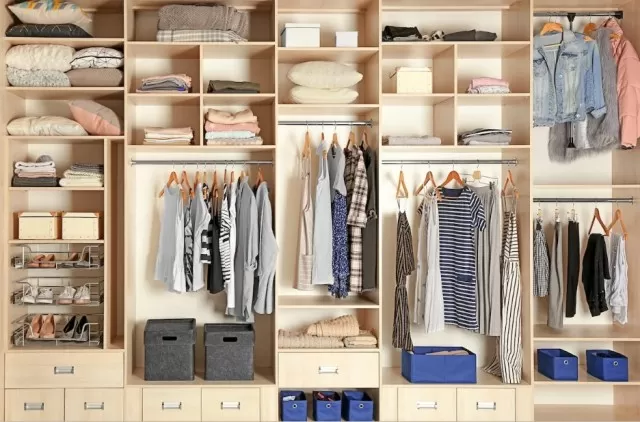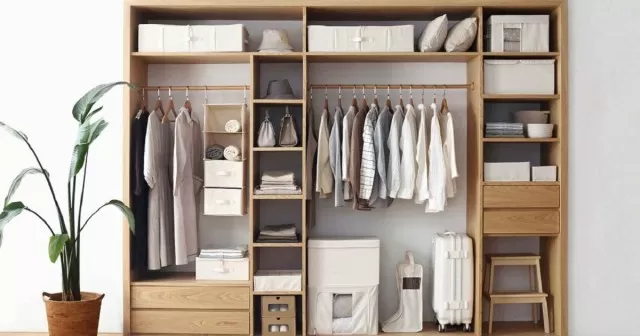Organizing your clothing can be a challenge because there isn’t a one-size-fits-all solution that works for every item in your wardrobe.
It’s important to recognize that different types of clothes require specific organization methods to ensure effective storage.
For instance, you wouldn’t organize your knit sweaters in the same way as your dresses or socks. To maintain neatness and accessibility, you’ll need to employ various clothing organization techniques for different garments and accessories.
Why Do You Have To Organize Clothes?

Whether you’re organizing clothes in a closet, dresser, or wardrobe, it’s crucial not to overcrowd the space.
Squeezing too many pieces into a tight area can lead to wrinkles and make it difficult to see all your clothing options when selecting an outfit. Opting for open storage solutions, such as hanging clothes or arranging garments on shelves, works best for everyday items like pants, sweaters, blouses, and dresses.
Having a clear view of your entire wardrobe prevents you from repeatedly wearing the same few pieces. On the other hand, items like socks, underwear, and accessories are better stored in drawers or bins, keeping them contained and hidden if desired.
By following these clothing organization tips, you can maintain a tidy and easily accessible wardrobe.
Ways for Organizing Clothes in Closet

Streamline Your Wardrobe First.
Before you dive into organizing your clothes, it’s essential to declutter your wardrobe.
Take the time to go through your clothes and remove items that no longer serve you. Consider donating clothes that haven’t been worn in a year, no longer fit, are damaged beyond repair, or are out of style.
This will create more space in your closets and drawers. Additionally, invest in closet systems, over-the-door racks, and drawer organizers to keep your remaining garments neatly organized.
Display Foldable Items for Easy Access.
For garments like sweaters, jeans, and t-shirts that don’t need to be hung, consider utilizing bookcases or open shelves.
These allow you to see and retrieve your clothes quickly. Place a bookcase inside your closet and arrange stacks of foldable items, organized by type.
Use labeled baskets to corral socks and delicates, keeping them easily accessible.
Categorize Hanging Clothes.
To make it easier to find specific clothing items, divide your hanging clothes into categories.
Use a labeling system on your closet rod to indicate where each category belongs. Storing similar items together, such as jackets or button-down shirts, will streamline your clothing storage and prevent overcrowding.
Repurpose drapery-rod clips to display handwritten tags that designate different clothing sections.
Keep Mending Tools Handy.
Organize your clothes and the tools needed for garment maintenance in the same area.
This ensures that you’re more likely to address small repairs, such as replacing buttons or fixing hems. Store a mending kit, button jar, iron, and ironing board near your clothes.
With these tools readily available, you can quickly fix any flaws or wrinkles, preventing garments from going unused.
Use Wood Hangers for Special Garments.
Hang your best clothing pieces, such as dresses, jackets, and delicate blouses, on wooden hangers.
These hangers provide sturdy support and help your clothes maintain their shape while in storage. To streamline your morning routine, organize a week’s worth of outfits using day-of-the-week dividers.
This allows you to plan and address any cleaning or repairs needed before wearing each outfit.

Utilize the Back of a door.
Make the most of your storage space by using the back of a door.
Install over-the-door hooks, shoe bags, or multi-hook racks to hang freshly ironed outfits, store hats, or hang heavier items like robes or coats. Alternatively, add a pegboard to the front or back of a door to organize smaller accessories such as scarves, ties, and belts using hooks.
Customize Your Closet Organization.
Maximize your closet’s storage capacity by incorporating various clothing organizers available in the market.
Customizable closet systems, specialty racks, storage bins, shelf dividers, drawer organizers, and hanging compartmentalized bags can all help optimize clothes storage. Get creative and use vintage hat boxes, suitcases, or planters to beautifully store rarely-used clothing, accessories, and out-of-season apparel.
Freestanding Wardrobe Organization.
If you have space, consider using a freestanding wardrobe or antique armoire for additional clothing storage.
Customize the interior of the cabinet with modern bin storage systems and adjustable closet rods at different heights to accommodate hanging clothes. Utilize shoe racks and storage bins based on available space.
Hang bulletin boards on the door to showcase outfit sketches, inspiring your favorite looks.
Organize Kids’ Clothes.
For children’s clothing, opt for multitier closet systems with dual rods.
Use the lower rod to sort clothes with day-of-the-week dividers. To help kids identify what’s stored in each drawer or bin, stencil, paint, or sketch an image on the front of each storage unit.
Utilize Clothing Storage Under the Bed.
Make use of under-bed organizers, such as plastic boxes, fabric bags, wire racks, or wooden drawers, to store seasonal clothing or items that are not frequently used.
These organizers can hold folded sweaters, jeans, extra robes, socks, and out-of-season garments like swimsuits or winter scarves. Look for options that include shoe organizer inserts, as moving shoes out of your closet can create a tidier look and free up more space for clothing storage.
By utilizing the space under your bed, you can maximize your clothing organization and keep items easily accessible yet out of sight.
*The information is for reference only.